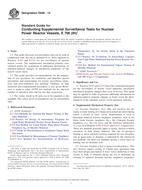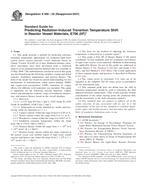We need your consent to use the individual data so that you can see information about your interests, among other things. Click "OK" to give your consent.
ASTM E798-96(2009)
Standard Practice for Conducting Irradiations at Accelerator-Based Neutron Sources
STANDARD published on 1.8.2009
The information about the standard:
Designation standards: ASTM E798-96(2009)
Note: WITHDRAWN
Publication date standards: 1.8.2009
SKU: NS-48025
The number of pages: 13
Approximate weight : 39 g (0.09 lbs)
Country: American technical standard
Category: Technical standards ASTM
The category - similar standards:
Annotation of standard text ASTM E798-96(2009) :
Keywords:
accelerators, cyclotrons, fusion, ion irradiation, radiation damage simulation, spallation, Deuterium-tritium interactions, Fast neutron flux/fluence, Irradiance/irradiation, Lithium/beryllium targets, Neutron activation reactions, Neutron flux/fluence, Neutron radiation--nuclear materials/applications, Radioactivation--fast neutron flux, Threshold detectors--14 MeV, Accelerators, Beryllium-lithium targets, Cyclotrons, ICS Number Code 27.120.10 (Reactor engineering)
Additional information
| 1. Scope | ||||||||||||||||||||||
|
1.1 This practice covers procedures for irradiations at accelerator-based neutron sources. The discussion focuses on two types of sources, namely nearly monoenergetic 14-MeV neutrons from the deuterium-tritium T(d,n) interaction, and broad spectrum neutrons from stopping deuterium beams in thick beryllium or lithium targets. However, most of the recommendations also apply to other types of accelerator-based sources, including spallation neutron sources (1). Interest in spallation sources has increased recently due to their proposed use for transmutation of fission reactor waste (2). 1.2 Many of the experiments conducted using such neutron sources are intended to simulate irradiation in another neutron spectrum, for example, that from a DT fusion reaction. The word simulation is used here in a broad sense to imply an approximation of the relevant neutron irradiation environment. The degree of conformity can range from poor to nearly exact. In general, the intent of these simulations is to establish the fundamental relationships between irradiation or material parameters and the material response. The extrapolation of data from such experiments requires that the differences in neutron spectra be considered. 1.3 The procedures to be considered include methods for characterizing the accelerator beam and target, the irradiated sample, and the neutron flux and spectrum, as well as procedures for recording and reporting irradiation data. 1.4 Other experimental problems, such as temperature control, are not included. 1.5 The values stated in SI units are to be regarded as standard. No other units of measurement are included in this standard. 1.6 This standard does not purport to address all of the safety concerns, if any, associated with its use. It is the responsibility of the user of this standard to establish appropriate safety and health practices and determine the applicability of regulatory limitations prior to use. |
||||||||||||||||||||||
| 2. Referenced Documents | ||||||||||||||||||||||
|
Similar standards:
Historical
1.2.2014
Historical
1.1.2014
Historical
1.8.2009
Historical
1.1.2013
Historical
1.1.2014
Historical
15.7.2007
We recommend:
Updating of laws
Do you want to be sure about the validity of used regulations?
We offer you a solution so that you could use valid and updated legislative regulations.
Would you like to get more information? Look at this page.



 ASTM E2956-14
ASTM E2956-14 ASTM E509/E509M-14..
ASTM E509/E509M-14.. ASTM E521-96(2009)e1..
ASTM E521-96(2009)e1.. ASTM E531-13
ASTM E531-13 ASTM E636-14
ASTM E636-14 ASTM E900-02(2007)..
ASTM E900-02(2007)..
 Cookies
Cookies
